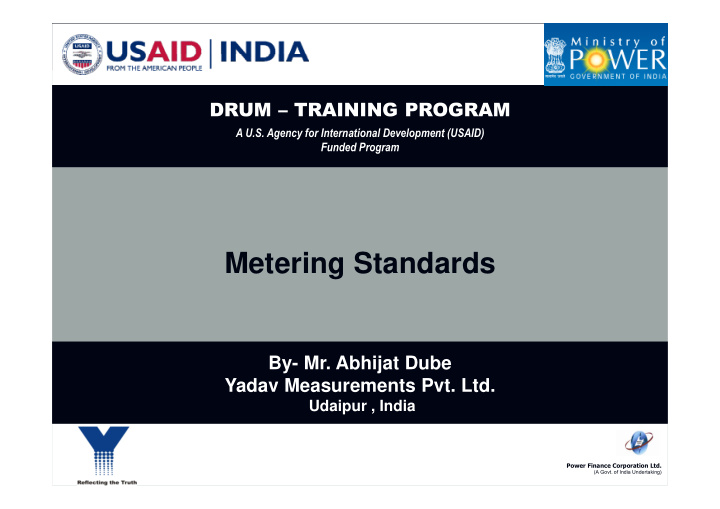



DRUM – TRAINING PROGRAM A U.S. Agency for International Development (USAID) Funded Program Metering Standards By- Mr. Abhijat Dube Yadav Measurements Pvt. Ltd. Udaipur , India Power Finance Corporation Ltd. (A Govt. of India Undertaking)
Electricity Metering technologies and systems Metering Standards-1 2
Electricity Metering technologies and systems Areas Covered Under this Module 1. Why standards? 2. How standards are made? 3. What is an standard? 4. Changes in standards 5. Metering standards 6. Various requirements of metering standards 7. Visit to YMPL 3
Why standards? • Standardization • Interchangeability • Fitting • Manufacturability • Economy • Quality control • Safety 4
Making of an standard • National committee – BIS, ANSI, BS • International committee – ISO, IEC • Who forms committee? – Users – Manufacturers – Renowned specialists • Circulation of draft and feedback • Releasing final standard 5
Making of an standard Sectional Working Initial committee Group Draft Wide Draft Sectional Circulation committee Feedback/ Sectional Final comments committee Standard 6
Standards – counterpoints • Impedes innovations • Satisfying standards – Not a performance guarantee • Standards Jungle 7
Contents of an standard • First page • Foreword • Introduction • Scope • References • Definitions – e.g. Meter type • Requirements • Appendixes 8
Number Name Publisher Price group 9
Definitions • meter type (for static meter) – term used to define a particular design of meter, manufactured by one manufacturer, having: a) similar metrological properties; b) the same uniform construction of parts determining these properties; c) the same ratio of the maximum current to the reference current. 10
Changes in standards • Reviewed by committee • Changes issued in capsules • How do we know? – Hand books – Magazines – Various companies 11
Metering standards • Solid state meters – IEC 60687 : alternating current static watt- hour meters for active energy (class 0.2 and 0.5) – IEC 61036 : alternating current static watt- hour meters for active energy (class 1 and 2) – IEC61268 : alternating current static Var-hour meters for reactive energy (class 2 and 3) – All above three has been withdrawn 12
New IEC standards for Static Meters IEC 62052-11 Electricity metering equipment (AC)-General requirements, tests and test conditions Part 11: Metering equipment IEC 62053-21 Static meters for active energy (Class 1 & Class 2): Particular requirements IEC 62053-22 Static meters for active energy (Class 0.2S & Class 0.5S): Particular requirements IEC 62053-23 Static meters for reactive energy (Class 2 & Class 3):Particular requirements 13
Solid state meters (contd.) – IS 13779 - 1999 : ac static watt-hour meters (class 1 and 2): Amd 1 & 2 & 3 &4 – IS 14697 - 1999 : ac static watt-hour and Var- hour meters (class 0.2s, 0.5s and 1s): Amd 1 & 2 & 3 – CBIP report 88 : specification for ac static electrical energy meters – Publication 304 -2008 issued by CBIP 14
More information at….. • www.iec.ch • www.bis.org.in 15
Requirements for static meters • Standard electrical values • Tests of accuracy requirements • Insulation requirements and tests • Climatic requirements and tests • Electrical requirements and tests • Electromagnetic compatibility • Mechanical requirements and tests 16
Standard electrical values – Standard reference voltage • e.g. 120-230-277-400-480 V – Standard reference current • e.g. 1, 2 and 5 A – Maximum current – Standard reference frequency 17
Tests of accuracy requirements • Accuracy with variation in load conditions • Test of meter constant • Test of starting conditions • Test of no load conditions • Test of influence quantities 18
Mechanical requirements – Safety • Safety of surroundings (operator and others) • Safety of meter 19
Safety of surroundings – Personal safety against electric shock • Provide electrical insulation – Insulation tests • Provide earthing – Personal safety against effects of excessive temperature • Test of heating • Less power consumption 20
Safety of meter – Protection against spread of fire • Quality of plastic • Resistance to heat and fire test – Protection against penetration of solid objects, dust and water • Packaging design 21
Case • Proper sealing • Cover not removable w/o tool • No effect of nonpermanent deformation • Earthing , if metallic 22
Mechanical requirements (contd.) • Window – For display, operational indicator – Not removable w/o damage 23
Terminal block – Adequate mechanical strength • Heat deflection test – Adequate insulation • Insulation tests – Hole diameter – Proper tightening method – Clearance and creepage distances 24
Mechanical requirements (contd.) • Display of measured value – Identification of tarriffs – 1500 HOUR @ Imax, Vn, upf LOGGING • Test output • Marking of meter – Make, type, Number of phases, S. No. , year, rated voltage, basic current, imax, frequency, Meter constant, class, Reference Temperature • Connection diagram and terminal marking 25
Mechanical Tests – • Spring Hammer Test • Vibration test • Shock test • Ingress protection • Resistance to heat and fire 26
Electrical requirements • Power Consumption • Voltage dips and short interruptions • Short time over current • Influence of self heating • Heating • Immunity to earth fault 27
Insulation Test • Safety First – Ac voltage – Impulse voltage – Insulation resistance measurement 28
Relative Humidity Moisture in air at defined temp. *100 -------------------------------------------- Moisture in same air under saturated condition (Actual Vapor Density) Relative Humidity (RH) = -------------------- X 100% (Saturation Vapor Density) 29
Recommend
More recommend